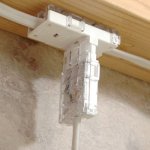kbsparky
Senior Member
- Location
- Delmarva, USA
I had a customer complain about lights flickering. Upon investigation, it seems that the lights flicker while his wife was using an iron in their bedroom.
So, I took some measurements:
Voltage in bedroom with several lamps lit: 120
Voltage measured with iron on too: 105
I checked the Volts and Amps at the panel as well:
Lamps only: 122 Volts, 2 Amps
Lamps w/iron: 120 Volts, 9.5 Amps
So, there seems to be a 15 Volt difference from the panel to the outlet(s) in the bedroom.
I figure that there is about 125-150 feet of 14/2 NM cable involved.
This is a "double-wide" home, so there is a "crossover" connection underneath, as well as those nasty non-box outlets. Which means you can't check their internal connections without tearing them apart.
I figure that the best remedy here is to remove all those non-box devices, install some boxes, and then use some real duplex outlets. Same goes for that plug-in crossover: Cut it out and hard-wire a permanent connection.
What should be the voltage drop on a circuit with 150 feet of 14/2 and a load of 9.5 Amps?
So, I took some measurements:
Voltage in bedroom with several lamps lit: 120
Voltage measured with iron on too: 105
I checked the Volts and Amps at the panel as well:
Lamps only: 122 Volts, 2 Amps
Lamps w/iron: 120 Volts, 9.5 Amps
So, there seems to be a 15 Volt difference from the panel to the outlet(s) in the bedroom.
I figure that there is about 125-150 feet of 14/2 NM cable involved.
This is a "double-wide" home, so there is a "crossover" connection underneath, as well as those nasty non-box outlets. Which means you can't check their internal connections without tearing them apart.
I figure that the best remedy here is to remove all those non-box devices, install some boxes, and then use some real duplex outlets. Same goes for that plug-in crossover: Cut it out and hard-wire a permanent connection.
What should be the voltage drop on a circuit with 150 feet of 14/2 and a load of 9.5 Amps?


